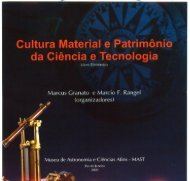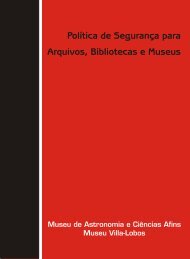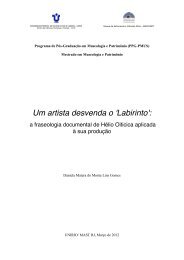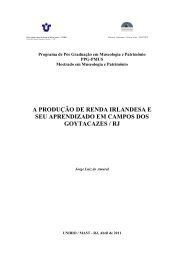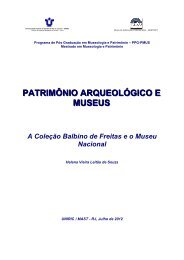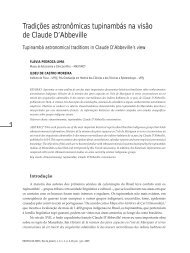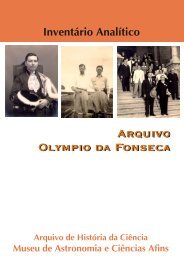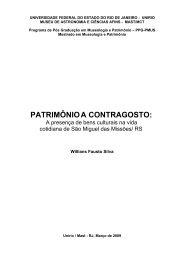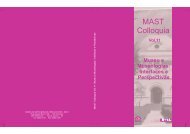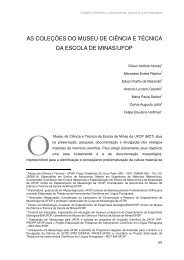- Page 2 and 3:
Anais 2º Congresso Latino-American
- Page 4 and 5:
2º CONGRESSO LATINO AMERICANO DE R
- Page 6 and 7:
SESSÃO TÉCNICA II Tema: Procedime
- Page 8:
SESSÃO TÉCNICA IV Tema: Estudos d
- Page 12:
C O N F E R Ê N C I A S 11
- Page 16 and 17:
A CONSERVAÇÃO DE OBJETOS DE PRATA
- Page 18 and 19:
Outra possibilidade é que, embora
- Page 20 and 21:
Fig. 3 - Plaquetas de prata exposta
- Page 22 and 23:
Fig. 6 - Secção transversal de pl
- Page 24 and 25:
Fig. 8 - Comparação esquemática
- Page 26 and 27:
A conservação de objetos de prata
- Page 28:
[6] Graedel, T.E., Franey, J.P., Gu
- Page 32 and 33:
LA APLICACIÓN DE QUÍMICOS EN LA R
- Page 34 and 35:
condiciones climáticas estaba prod
- Page 36 and 37:
− Metales y aleaciones no ferrosa
- Page 38 and 39:
elevada, como también se observa c
- Page 40 and 41:
La pátina que se forma en este amb
- Page 42 and 43:
La distribución espacial que se fo
- Page 44 and 45:
La presencia de hongos es también
- Page 46 and 47:
cerrarse, los químicos quedarán a
- Page 48 and 49:
El iniciador, usualmente peróxido
- Page 50 and 51:
(disolución por formación de comp
- Page 52:
Ciência e restauração Prof. Dr.
- Page 55 and 56:
computacionais nesta última décad
- Page 57 and 58:
competição, às vezes acirrada en
- Page 59 and 60:
4.3 - RESTAURAÇÃO DE PRÉDIOS HIS
- Page 62:
Metalurgia Andina: La Transformacio
- Page 65 and 66:
1.2 - PLATA Es un metal blanco y br
- Page 67 and 68:
- ALEACION ORO CON PLATA: Los orfeb
- Page 69 and 70:
Soldadura: Es la unión de dos o ma
- Page 71 and 72:
2.7 - HERRAMIENTAS Y MATERIALES Alg
- Page 73 and 74:
Tumba 2: Esta estructura se ubica a
- Page 75 and 76:
3.9 - MOCHE ( 200 D.C. Aprox hasta
- Page 77 and 78:
parte de Perú y es un largo camina
- Page 80 and 81:
PATRIMÔNIO CULTURAL EM OURO E PRAT
- Page 82 and 83:
elementar isotopica metalografica t
- Page 84 and 85:
Deve, no entanto, tomar-se em linha
- Page 86 and 87:
Figura 2: Simulação da técnica d
- Page 88 and 89:
Figura 4: Medida obtida por micro-t
- Page 90 and 91:
- A ourivesaria Além da determina
- Page 92 and 93:
Todos os constituintes modernos des
- Page 94 and 95:
A primeira notícia da chegada de o
- Page 96 and 97:
Deste modo, as moedas cunhadas pela
- Page 98 and 99:
Figura 13: uma das coroas do tesour
- Page 100 and 101:
geralmente informações importante
- Page 102 and 103:
Cauuet B. 1991. L'exploitation de l
- Page 104 and 105:
SESSÕES TÉCNICAS SESSÃO TÉCNICA
- Page 106 and 107:
Os mercados de Belém: um estudo so
- Page 108 and 109:
OS MERCADOS DE BELÉM: UM ESTUDO SO
- Page 110 and 111:
2 - OS MERCADOS DE BELÉM: UM ESTUD
- Page 112 and 113:
E, finalmente, discutir, dentro das
- Page 114 and 115:
3 - CONSIDERAÇÕES FINAIS: Apesar
- Page 116 and 117:
La restauración física de campana
- Page 118 and 119:
LA RESTAURACIÓN FÍSICA DE CAMPANA
- Page 120 and 121:
Estudo de revestimentos para monume
- Page 122 and 123:
ESTUDO DE REVESTIMENTOS PARA MONUME
- Page 124 and 125:
uma maior taxa de corrosão. Os mei
- Page 126 and 127:
A Figura 1 mostra o esquema montado
- Page 128 and 129:
SP 5 CA A B C D FIGURA 5 - Superfí
- Page 130 and 131:
Na Figura 9 observa-se que as amost
- Page 132 and 133:
Bronze revestido com Paraloid B-72,
- Page 134 and 135:
Intervención de bronces exteriores
- Page 136 and 137:
INTERVENCIÓN DE BRONCES EXTERIORES
- Page 138 and 139:
Avaliação da resistência à corr
- Page 140 and 141:
AVALIAÇÃO DA RESISTÊNCIA À CORR
- Page 142 and 143:
SESSÕES TÉCNICAS SESSÃO TÉCNICA
- Page 144 and 145:
Caracterização espectroscópica d
- Page 146 and 147:
1. INTRODUÇÃO Este trabalho conce
- Page 148 and 149:
Figura 2 - PIXE externo (à direita
- Page 150 and 151:
A análise pode ser feita sobre tod
- Page 152 and 153:
Porcentagem (%) 70 60 50 40 30 20 1
- Page 154 and 155:
Figura 9 - Foto geral da peça B e
- Page 156 and 157:
S Ar P Cl Cu Au Fe Figura 12 - Espe
- Page 158 and 159:
REFERÊNCIAS 1. Salum, M.H.L e Cera
- Page 160 and 161:
Conservación & restauración del p
- Page 162 and 163:
CONSERVACIÓN & RESTAURACIÓN DEL P
- Page 164 and 165:
una muestra amplia de piezas de met
- Page 166 and 167:
Laboratorios comprometidos permite
- Page 168 and 169:
Cuantificación análisis EDAX ZAFd
- Page 170 and 171:
Cu, contando siempre con el apoyo d
- Page 172 and 173:
Fig. 7. Limpiezas con Láser. Fig.8
- Page 174 and 175:
del que hay numerosos testimonios m
- Page 176 and 177:
En estos primeros meses de ejecuci
- Page 178 and 179:
-Borrós et al. (1998) Application
- Page 180 and 181:
Estudio metalúrgio de un casco gri
- Page 182 and 183:
4. INTRODUCCIÓN El presente trabaj
- Page 184 and 185:
4. DISCUSIÓN DE LOS RESULTADOS El
- Page 186 and 187:
Referencias 1. KUNZE, e. Bericht ü
- Page 188 and 189:
Fig. 4.- Protector nasal en el que
- Page 190 and 191:
. Fig. 7.- Micrografía que muestra
- Page 192 and 193:
Restauração do chafariz monumenta
- Page 194 and 195:
RESTAURAÇÃO DO CHAFARIZ MONUMENTA
- Page 196 and 197: Fig.3 - Vista do atlante velho entr
- Page 198 and 199: CORPO DA CARIÁTIDE ZÉFI ROS GERAL
- Page 200 and 201: 2.7.2 Descrição dos danos 14. CAB
- Page 202 and 203: 2.9.2 Descrição dos danos 15. PLA
- Page 204 and 205: 2.12 Taças 2.12.1 Descrição da p
- Page 206 and 207: 2.13 Pedestal dos Continentes 2.13.
- Page 208 and 209: 2.14.2 Descrição dos danos Em tod
- Page 210 and 211: 2.16.2 Descrição dos danos PEDEST
- Page 212 and 213: La interpretación radiográfica co
- Page 214 and 215: LA INTERPRETACIÓN RADIOGRÁFICA CO
- Page 216 and 217: Con respecto a la captación de la
- Page 218 and 219: parte opuesta al vertido, de forma
- Page 220 and 221: un ligero sobreespesor. En las escu
- Page 222 and 223: Doríforo (Figs. 5 y 6) 6 Estas dos
- Page 224 and 225: Figura 1 223
- Page 226 and 227: Figura 4 225
- Page 228 and 229: Figura 7 227
- Page 230 and 231: Caracterização microestrutural de
- Page 232 and 233: CARACTERIZAÇÃO MICROESTRUTURAL DE
- Page 234 and 235: Figura 1 - Moeda de cobre. Reverso
- Page 236 and 237: As inclusões correspondem às regi
- Page 238 and 239: Figura 7 - Espectros de PIXE, detec
- Page 240 and 241: Figura 10 - Espectros de PIXE, dete
- Page 242 and 243: SESSÕES TÉCNICAS SESSÃO TÉCNICA
- Page 244 and 245: Restauración y conservación de me
- Page 248 and 249: El bloque de concreción, formado p
- Page 250 and 251: Evaluación de los resultados A pes
- Page 252 and 253: Fig. 8 (Izq.) Muestra OB.0604p2x5,
- Page 254 and 255: 2.3 - Cuchara de plata La cuchara e
- Page 256 and 257: Solución: 25 g de Ácido Fórmico
- Page 258 and 259: concreción- y comportamientos dist
- Page 260 and 261: La Conservacion de las coronas de m
- Page 262 and 263: LA CONSERVACION DE LAS CORONAS DE M
- Page 264 and 265: Presentación Justificación Antece
- Page 266 and 267: Fig. 2 - Archivo CNCPC. Entrevista
- Page 268 and 269: Fig. 6 - Archivo CNCPC. Corona de a
- Page 270 and 271: 2. En el caso de la corona con flor
- Page 272 and 273: Fig. 14: Archivo CNCPC. Tratamiento
- Page 274 and 275: Restauração de um teodolito astro
- Page 276 and 277: RESTAURAÇÃO DE UM TEODOLITO ASTRO
- Page 278 and 279: O microscópio eletrônico de varre
- Page 280 and 281: demonstraram a existência de duas
- Page 282 and 283: de Fabricantes Franceses de Instrum
- Page 284 and 285: visando o melhoramento sanitário d
- Page 286 and 287: estavam alinhadas e parafusadas no
- Page 288 and 289: Quanto às peças que estão ausent
- Page 290 and 291: profundas foram mantidas para não
- Page 292 and 293: a b Figura 6 (a e b,) - Teodolito r
- Page 294 and 295: dimensões necessárias com caneta
- Page 296 and 297:
19. MUSEU DE ASTRONOMIA E CIÊNCIAS
- Page 298 and 299:
Análisis, conservación y restaura
- Page 300 and 301:
ANALISIS, CONSERVACION Y RESTAURACI
- Page 302 and 303:
mantiene con la misma distribución
- Page 304 and 305:
Surgen varias preguntas: Cómo logr
- Page 306 and 307:
Fig. 3 - Hilo del traje del ángel,
- Page 308 and 309:
Fig. 7 - Malla del hilo del traje d
- Page 310 and 311:
Restauración del Cristo Nazareno:
- Page 312 and 313:
Después de la restauración se col
- Page 314 and 315:
Restauración integral de una igles
- Page 316 and 317:
RESTAURACIÓN INTEGRAL DE UNA IGLES
- Page 318 and 319:
SESSÕES TÉCNICAS SESSÃO TÉCNICA
- Page 320 and 321:
A coleção numismática do Museu H
- Page 322 and 323:
A COLEÇÃO NUMISMÁTICA DO MUSEU H
- Page 324 and 325:
O objetivo da higienização de uma
- Page 326 and 327:
Como procedimentos habituais adotad
- Page 328 and 329:
Figura 2: Imagem do MEV (aumento de
- Page 330 and 331:
A região 1 corresponde à camada d
- Page 332 and 333:
zona 3 zona 4 zona 5 Parece, a part
- Page 334 and 335:
A região 1 corresponde à camada d
- Page 336 and 337:
Eliminación de productos de corros
- Page 338 and 339:
ELIMINACIÓN DE PRODUCTOS DE CORROS
- Page 340 and 341:
sobre las superficies una amalgama
- Page 342 and 343:
DORADO Para realizar el dorado de l
- Page 344 and 345:
MÉTODOS DE LIMPIEZA De estas 10 pr
- Page 346 and 347:
Los resultados observados en la pro
- Page 348 and 349:
Imagen. 9. Vista al microscopio est
- Page 350 and 351:
El quitosan puede actuar de dos for
- Page 352 and 353:
4-10, disponible en http://www.remc
- Page 354 and 355:
Avaliação da degradação de vern
- Page 356 and 357:
AVALIAÇÃO DA DEGRADAÇÃO DE VERN
- Page 358 and 359:
onde φ é o ângulo de fase, ou se
- Page 360 and 361:
3. RESULTADOS E DISCUSSÃO A Figura
- Page 362 and 363:
diferentes números de ensaios ao l
- Page 364 and 365:
Cera microcristalina exposta ao amb
- Page 366 and 367:
esina B-72 apresenta impedâncias s
- Page 368 and 369:
4. CONCLUSÕES Os resultados mostra
- Page 370 and 371:
Limpieza láser de una Isis egipcia
- Page 372 and 373:
LIMPIEZA LÁSER DE UNA ISIS EGIPCIA
- Page 374 and 375:
2.- PROCESO DE FABRICACIÓN La figu
- Page 376 and 377:
seleccionado para este trabajo un l
- Page 378 and 379:
Figura 3. Análisis general de las
- Page 380 and 381:
Figura 7. Análisis realizado sobre
- Page 382 and 383:
Estudo dos compostos obtidos na rem
- Page 384 and 385:
ESTUDO DOS COMPOSTOS OBTIDOS NA REM
- Page 386 and 387:
2 - EXPERIMENTAL 2.1 - SÍNTESES 2.
- Page 388 and 389:
TABELA 1 - Valores de absorção do
- Page 390 and 391:
Tabela 3 - Resultados da análise e
- Page 392 and 393:
Figura 7 - Comparação dos espectr
- Page 394 and 395:
sido sais e óxidos de chumbo e cob



